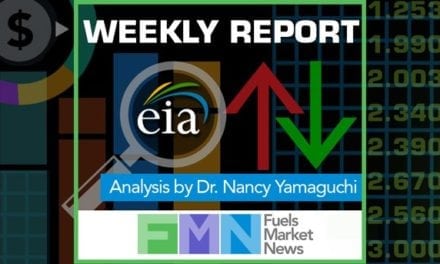By Keith Reid
On October 1, EPA announced its finalized Ozone Rule, lowering the existing standard from 75 parts per billion to 70ppb. The agency had threatened to potentially lower it to 65ppb. There is not much to add that wasn’t covered previously at FMN in this article from when the specifics of the then upcoming finalized rule were being discussed, beyond the final number EPA would set. The factual points and fundamental editorial positons remain the same.
Offered below are the latest public reactions of various groups to the final rule.
API Calls On Congress to Block the Unnecessary Ozone Regulations
Congress must move legislation to slow EPA’s rush to further tighten regulations on ozone that could be the costliest regulation ever imposed on the American public, even as current standards are already improving air quality, according to API President and CEO Jack Gerard.
“Current ozone standards protect public health without further stifling jobs or harming our economy,” Gerard said. “Our nation’s air is getting cleaner as we implement the existing standards, but the administration ignored science by changing the standards before allowing current standards to work. It’s time for Congress to step in and block this unnecessary and costly regulation to protect American consumers.”
http://www.api.org/news-and-media/news/newsitems/2015/october-2015/api-calls-on-congress-to-block-the-unnecessary-ozone-regulations
NACS: EPA Issues Potentially Costliest Regulations In History
The new ozone [National Ambient Air Quality Standards] will be very controversial in Congress. Republicans have been highly critical of a lower ozone standard, stating that nonattainment designations under the standard could negatively impact economic development in designated nonattainment areas.
Anticipating the release of the final rule, the Senate Environment and Public Works Committee held a hearing this week on the EPA’s clean air policies, including the updated ozone standard. Chairman Jim Inhofe (R-OK) stated that a more stringent ozone standard will be one of the costliest regulations in history and have detrimental effects on the economy. While Republicans may seek to block the new ozone standard through legislation, such efforts would most likely face a presidential veto.
http://www.nacsonline.com/News/Daily/Pages/ND1002151.aspx#.VhP2THpVhBc
PMAA Weekly Review: Oct. 2, 2015
Yesterday, the EPA set the new ozone standard at 70 parts per billion (ppb), a significant reduction from the 75ppb level set in 2008. The 70 ppm standard is not as low as many feared and is considered a compromise between industry and environmental interests. The rule is important to petroleum marketers because it could lead to additional RFG or lower RVP mandates for those counties nationwide which are not in attainment with the new standard.
Depending on the severity of their ozone problem, states and counties will have from 2020 to 2037 to meet the new standard. The EPA estimates that 241 counties will be pushed into nonattainment due to the reduction in the standard. The EPA will determine the severity of the ozone problem in these counties no later than October 1, 2017. The agency considers 3 years of air monitoring data to determine if an area is in marginal, moderate, serious, severe or extreme nonattainment. RFG is mandated for serious, severe and extreme nonattainment areas.
http://www.pmaa.org/weeklyreview/
The Hill: EPA’s ozone decision is about politics, and that’s OK
By Stuart Shapiro (Oct. 06, 2015)
The EPA (under the Obama administration as well as all of its predecessors, both Democratic and Republican) does not want to admit that it makes political decisions. That would give validity to the critics who cite the insufficient science or economics behind the standard as evidence that the agency caved to interest groups on the other side of the issue. But in deciding between multiple options that can be justified by economics and science, agencies and the presidents they work for weigh the reactions of the groups that care about their policies. In other words, they make political decisions.
http://thehill.com/blogs/pundits-blog/energy-environment/256015-epas-ozone-decision-is-about-politics-and-thats-ok
WSJ: EPA Sets Stricter Standard for Ozone
By Amy Harder, Oct. 1, 2015
“I am relieved they didn’t go as far as they could have,” said Steve Staub, owner of Staub Manufacturing, a small company in Dayton, Ohio, that makes industrial products from raw metal. Mr. Staub, who founded his company 18 years ago and has 26 employees today, said a standard of 65 parts per billion would have been “unattainable for anyone in the manufacturing industry.”
http://www.wsj.com/articles/epa-to-set-stricter-air-pollution-standard-for-ozone-1443715727
NPR: New EPA Rule Limiting Ground-Level Ozone Draws Fire From All Sides
By Jeff Brady, Oct. 1, 2015
While acknowledging the tighter standard will provide health benefits, John Walke, senior attorney and director of the Clean Air Program at the Natural Resources Defense Council, says the EPA missed an opportunity to set an even lower level, closer to the 60 ppb.
“Setting the safest recommended standard would have saved almost 6,500 lives and avoided nearly 1.5 million more asthma attacks per year than the smog pollution level the administration has chosen,” said Walke.
http://www.npr.org/sections/thetwo-way/2015/10/01/445152019/new-epa-rule-limiting-ground-level-ozone-draws-fire-from-all-sides
National Association of Manufacturers
“Today, the Obama Administration finalized a rule that is overly burdensome, costly and misguided. For months, the Administration threatened to impose on manufacturers an even harsher rule, with even more devastating consequences. After an unprecedented level of outreach by manufacturers and other stakeholders, the worst-case scenario was avoided. But make no mistake: the new ozone standard will inflict pain on companies that build things in America—and destroy job opportunities for American workers. Now it’s time for Congress to step up and take a stand for working families.” Jay Timmons President and CEO, National Association of Manufacturers http://www.nam.org/ozone/#sthash.qn9QMhJX.dpuf
Think Progress: EPA Announces New Ozone Limits, Disappointing Environmental Groups
By Samantha Page, Oct 1, 2015
“This action falls far short of what’s needed to protect the one in 10 children who live with asthma,” Lisa Garcia, a vice president at Earthjustice, said in a statement. “The science shows that ozone is dangerous to these kids at the levels allowed by this new standard.”
The environmental law group predicted that the new standard would be challenged in court.
http://thinkprogress.org/climate/2015/10/01/3708087/epa-lowers-ozone-limits-a-little/
U.S. Chamber: EPA’s Tightened Ozone Standard Will Harm America’s Economic Growth
“The Obama administration’s endless regulatory overreach continues with tightened ozone rules that will present considerable problems for America’s economy, job creation, and the construction of critical infrastructure projects,” said U.S. Chamber of Commerce Executive Vice President for Government Affairs Bruce Josten. “Ignoring local and state officials’ warnings, the final standard will be extremely difficult for many areas to comply with, some of which have large amounts of naturally-occurring background ozone that is beyond their control. The fact that many national parks far from population centers will violate the new standard is proof that it makes little sense.”
https://www.uschamber.com/press-release/us-chamber-epa-s-tightened-ozone-standard-will-harm-america-s-economic-growth









